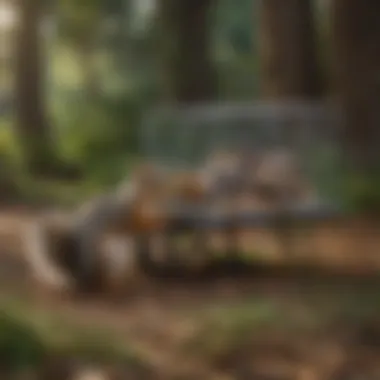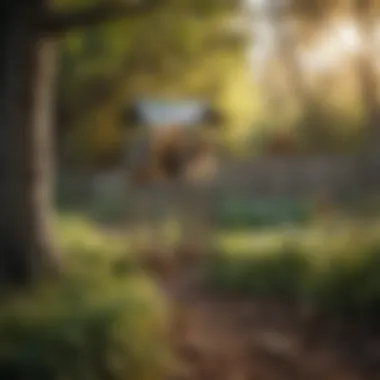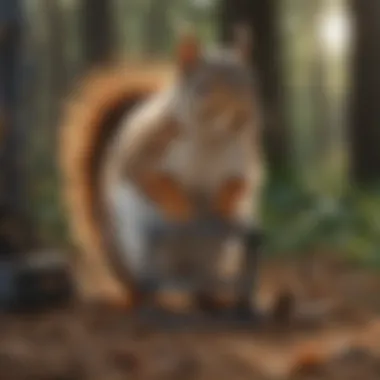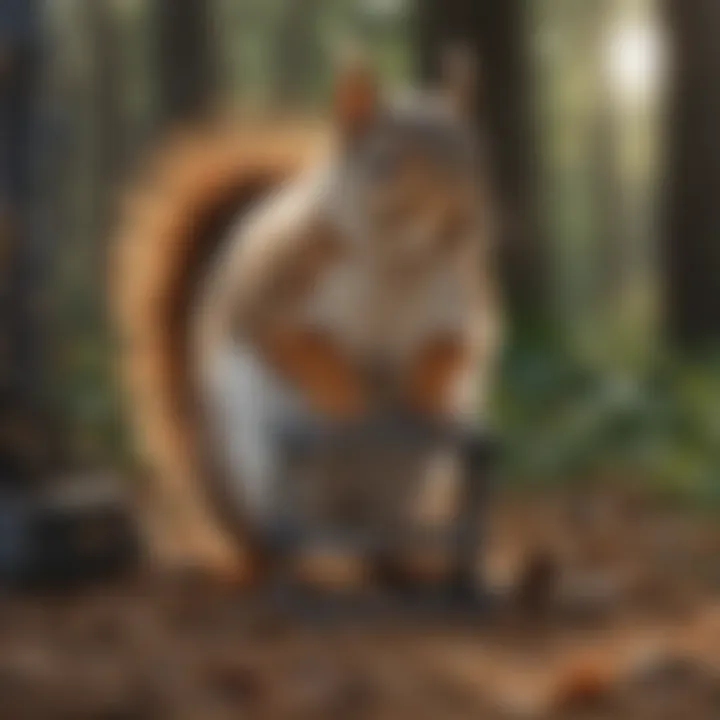Comprehensive Guide to the Best Squirrel Trap


Intro
Squirrel management is essential for maintaining harmony in your environment. Homeowners often encounter these critters, and the need for efficient solutions becomes apparent. This article serves as a detailed guide to the most effective squirrel traps available, offering valuable insights for housewives and homeowners alike.
By understanding various aspects of squirrel trapping, individuals can develop humane and effective pest management strategies. This guide will delve into essential topics, including pest identification, prevention strategies, and treatment options. The aim is to equip readers with thorough knowledge for handling squirrel-related issues.
Pest Identification
Understanding the types of squirrels and their behaviors is crucial. The common tree squirrel includes the Eastern Gray Squirrel, Red Squirrel, and Fox Squirrel. Each of these species displays unique traits and habits.
Detailed Descriptions of Common Pests
- Eastern Gray Squirrel: Usually gray in color. They can weigh up to one pound and have bushy tails.
- Red Squirrel: Smaller than gray squirrels, they are rust-colored. They weigh about half a pound and are known for their energetic movements.
- Fox Squirrel: The largest among common squirrels, it has a fox-like coloration and can weigh more than one pound.
Signs and Symptoms of Infestations
Recognizing the signs of a squirrel infestation early enhances the success of management efforts. Look for the following indicators:
- Nesting materials: Shredded paper, leaves, and twigs in attics or walls.
- Gnaw marks: Chewed wires or wooden structures can signal their presence.
- Droppings: Small, dark droppings are often found near nesting areas.
Squirrel infestations can damage property and pose health risks. Early detection is essential for successful control.
Prevention Strategies
Preventing a squirrel problem is generally more effective and humane than dealing with an established infestation. Here are practical steps to fortify your home.
Home Maintenance Tips for Pest Prevention
- Seal entry points: Inspect your home for gaps in roofing, siding, or vents. Seal these areas to prevent access.
- Remove food sources: Store birdseed, pet food, and garbage in sealed containers to avoid attracting squirrels.
- Maintain landscaping: Trim trees and shrubs to minimize access to your home.
Natural Deterrents and Barriers
Consider using natural deterrents to keep squirrels at bay. Some effective options include:
- Cayenne pepper: Sprinkling cayenne pepper around entry points may deter squirrels due to its strong scent.
- Motion-activated sprinklers: These devices startle squirrels and other pests, discouraging them from approaching.
Treatment Options
When prevention measures fail, and a squirrel problem arises, it is important to explore treatment options. Options include traps and other tools for humane capture and removal.
Overview of Chemical vs. Natural Treatments
- Chemical treatments: Usually not recommended due to potential harm to wildlife and pets. They should be avoided whenever possible.
- Natural treatments: Hiring a professional or using humane traps is often more effective and environmentally friendly.
Step-by-Step Guides for DIY Treatments
- Select a trap: Choose a humane trap designed specifically for squirrels, such as the Havahart 1081.
- Bait the trap: Use appealing bait like peanut butter or sunflower seeds.
- Set the trap: Place the trap near areas of squirrel activity.
- Monitor the trap: Check it frequently, especially during the early morning hours.
- Release the captured squirrel: Transport it to a suitable location at least five miles away from your home.
This guide aims to equip readers with the knowledge necessary for effective squirrel control practices while maintaining humane standards.
Understanding Squirrels and Their Behavior
Understanding squirrel behavior is vital for effective pest control. Knowing how these animals think and act can help homeowners make informed decisions. This section will explore the ecology of squirrels and the problems they can cause, creating a foundation for trap selection and management.
Ecology of Squirrels
Species overview
Squirrels belong to the family Sciuridae, which includes various species such as the eastern gray squirrel and the fox squirrel. Each species varies in size, color, and behavior. The eastern gray squirrel is most common in urban areas. Its adaptability and high reproductive rate make it a notable choice for pest control discussions. Understanding these species helps in creating effective trapping strategies.
Habitat preferences
Squirrels thrive in diverse habitats. They prefer wooded areas but have adapted well to suburban and urban settings. Their ability to live near humans increases the likelihood of conflicts. The presence of trees provides nesting and food sources. Knowing the habitats squirrels favor allows homeowners to anticipate visits and take preventive measures.
Feeding habits
Squirrels are omnivorous, consuming nuts, seeds, fruits, and even small insects. Their feeding habits influence their presence near homes, especially during autumn when they gather food for winter. Recognizing what attracts squirrels can aid in effective prevention. Properly securing trash and storing food can reduce the appeal of a property to these animals.
Common Problems Caused by Squirrels
Property damage
Squirrels can cause significant property damage. Theychew through wires, insulation, and wood, leading to costly repairs. This damage not only affects homes but also vehicles and other structures. By identifying signs of squirrel activity, homeowners can act early to prevent severe issues. Prompt action is essential to protect property.
Health risks


Squirrels carry parasites and diseases that pose health risks. They can transmit illnesses through droppings and scratches. Awareness of these risks is important for safe living conditions. Maintaining cleanup procedures can lessen exposure. Homeowners must understand the health implications of squirrel infestations to react appropriately.
Ecological impacts
While squirrels are part of the ecosystem, their overpopulation can lead to adverse effects. They can displace native species and disrupt local flora. Understanding their ecological role helps in maintaining balance. Wildlife management strategies should consider the nutritional needs and habitat of all species.
“Knowledge about squirrel behavior helps identify the best trapping methods and when to implement them.”
In summary, understanding squirrels and their behavior is essential for effective and responsible control measures. Knowledge of their ecology, feeding habits, and the problems they cause will aid in managing their population effectively while considering the impact on the wider environment.
Types of Squirrel Traps
Understanding the various types of squirrel traps is critical for effective pest management. Selecting the appropriate trap can greatly increase the chances of capturing the target animal while minimizing harm to both the squirrel and the environment. This section will examine four main varieties of traps, each with its own set of benefits and considerations.
Live Traps
Live traps are designed to catch squirrels without harming them. These traps allow for the safe removal of squirrels from residential areas. Because of their humane approach, many homeowners prefer them.
Advantages
One of the primary advantages of live traps is their ethical nature. They do not kill the animal, making them suitable for homeowners who prioritize humane practices. Additionally, live traps can be reused, which makes them more economical in the long run. They also allow for easy relocation of captured squirrels, often to a suitable habitat where they can thrive.
Disadvantages
Despite their favorable aspects, live traps are not without drawbacks. They can be sensitive, which might lead to non-target animals being caught. Additionally, regular monitoring is necessary; otherwise, the captured squirrel may face starvation or dehydration. This care requirement can be a limitation for those unable to check the traps frequently.
Recommended models
There are several well-regarded live traps on the market. The Havahart 1083 is a popular choice due to its effectiveness and ease of use. Similarly, the Tomahawk Live Trap 102 is praised for its durability and performance. Both models allow for safe trapping and provide the user with the knowledge that they are working toward humane control of their squirrel issues.
Snap Traps
Snap traps work by utilizing a quick mechanism to kill the animal when triggered. They are often used for their simplicity and effectiveness but require careful handling.
Mechanics of operation
The mechanics behind snap traps involve a spring-loaded bar that snaps into place when a squirrel triggers the bait. This mechanism is designed to be fast and effective, ensuring a quick kill. Their design allows for easy setting and deployment, which is a significant benefit for homeowners looking for straightforward solutions.
Size and effectiveness
The size of snap traps plays a crucial role in their effectiveness. There are different sizes available, depending on the target species. Using the correct size can dramatically increase capture rates. Larger traps may be more effective for bigger squirrels, while smaller ones can be underwhelming. Choosing the right size ensures optimal performance and minimizes unnecessary suffering for the animal.
Safety considerations
When using snap traps, safety is a prime concern. Proper placement away from children and pets is essential to avoid accidental injuries. Furthermore, understanding the mechanism ensures that users can set and check the traps without risk.
Electric Traps
Electric traps utilize a shocking mechanism to kill squirrels humanely. They have gained popularity due to their effectiveness and ease of use.
Working principles
Electric traps work by delivering a quick, lethal shock once the squirrel enters the trap and makes contact with two metal plates. This method is effective, ensuring a rapid death, which appeals to those concerned with humane practices. These traps often have designs that prevent escape, further increasing their reliability compared to other methods.
Efficiency
The efficiency of electric traps is commendable. They tend to have low maintenance needs and can handle multiple captures before a battery change is needed. This makes them a practical choice for homeowners with persistent squirrel issues, saving time and effort in the long run.
Cost analysis
While electric traps may have a higher initial cost compared to traditional traps, the efficiency and effectiveness can lead to lower overall costs in pest management. A carefully considered investment can yield benefits, especially for those dealing with larger infestations.
Glue Traps
Glue traps are sticky boards designed to capture squirrels without the use of bait or mechanical parts. Their simplicity makes them appealing but also raises ethical concerns.
Operational mechanism
The operational mechanism of glue traps is straightforward. Once a squirrel walks onto the sticky surface, it becomes trapped. This design requires less human intervention, making it easy to deploy in various locations.
Ethical concerns
Despite their ease of use, glue traps raise significant ethical concerns. Animals caught often suffer for extended periods, leading to distress and potential pain. Many animal rights advocates urge against the use of glue traps due to these concerns, emphasizing the need for humane solutions.
Situational use
Glue traps may be more effective in certain situations, such as in areas where traditional traps are impractical. For example, they may be deployed in attics or spaces where trap setting is difficult. However, their use should be carefully considered due to the ethical implications involved.


Selecting the Best Squirrel Trap
Selecting the right squirrel trap is essential for effective pest management. A well-chosen trap not only increases the chances of success but also ensures a humane approach to handling urban wildlife. Factors such as trap location, target demographics, and budget constraints guide the decision-making process. Understanding these elements helps in selecting a trap that is effective, safe, and appropriate for one’s specific needs.
Factors to Consider
Trap location
Trap location is one of the most critical aspects to consider when trapping squirrels. Choosing an appropriate location ensures maximum visibility and accessibility of the trap for squirrels. Ideal spots are typically near feeding sources or nesting sites. Traps set close to regular feeding places increase the likelihood of a successful capture. However, an important consideration is that the chosen location should be safe from human or pet interference; otherwise, it can lead to unintended injuries or ethical dilemmas. A beneficial choice for trap location is to observe squirrel activity and adjust placement accordingly.
Target demographics
Understanding the target demographics is vital in selecting an effective squirrel trap. Identifying the specific species and their behaviors can significantly influence trap choice. For example, larger tree squirrels may require a different trap size compared to smaller ground squirrels. Knowing which species is present helps in selecting a trap that matches their capture size. This knowledge also helps in determining bait and setting strategies that align with specific squirrel activities. Recognizing and catering to the target demographics enhances the chances of effective trapping.
Budget constraints
Budget constraints undeniably play a significant role in trap selection. Costs can vary widely between different types and models of traps. A budget-friendly trap could be sufficient for casual outdoor settings, while a more durable and expensive model may be necessary for recurrent squirrel problems. Additionally, considering long-term costs, such as maintenance and replacement, is equally essential. Balancing initial investment with functional efficacy and durability ensures that budget constraints do not compromise capture effectiveness.
Evaluating Trap Performance
Capture rate
The capture rate of a trap directly indicates its effectiveness. A higher capture rate means that more squirrels can be trapped successfully. This performance metric helps in assessing whether a trap is worth the investment. Some traps may come with claims of high capture rates, but individual experiences may vary. Regular evaluation of the actual capture rate can guide further trap adjustments or replacements based on real performance.
Durability
Durability is another critical aspect of trap performance. A durable trap can withstand weather changes and frequent usage without compromising functionality. Traps made from strong materials provide better longevity and reliability over time. Durability becomes particularly important in outdoor settings where environmental factors may come into play. A durable trap minimizes the frequency of replacements and repairs, offering better value in the long run.
Ease of use
Finally, the ease of use is a crucial factor in selecting a squirrel trap. A trap that is easy to install and operate can significantly enhance user experience. Complicated traps often lead to mistakes during setup, rendering them ineffective. Moreover, traps that are easy to clean and maintain also appeal to homeowners who are looking for hassle-free solutions. Assessing the user-friendliness of a trap can help choose the most suitable option for diverse skill levels and personal preferences.
Installing and Using Squirrel Traps
Installing and using squirrel traps is a critical component of pest management. A well-executed trapping strategy can significantly reduce squirrel populations in your area and prevent the associated damages they cause. Understanding the methods for proper installation and usage will enhance trap effectiveness and ensure humane treatment of the animals. This section will delve into best practices and their importance for achieving desirable results in squirrel control.
Best Practices for Installation
Selecting strategic locations
Selecting strategic locations for traps is paramount in this process. The primary goal is to position traps where squirrels are most likely to travel. Identifying these spots increases the chances of successful capture. Squirrels tend to follow specific pathways, often near food sources or nesting areas. Placing traps along these routes is effective.
A key characteristic of this practice is observing squirrel behavior. This approach is beneficial because it saves time and resources by maximizing trap placement efficiency. The unique feature of selecting these locations is its direct impact on the capture rate. Improper placement can lead to traps being ignored, reducing overall effectiveness.
Proper baiting techniques
Proper baiting techniques are also essential for attracting squirrels into traps. Using the right type of bait can make a significant difference in success rates. Foods like peanut butter, nuts, or fruits can entice squirrels more effectively than other options. The method of baiting may vary depending on the trap type, but the principle remains the same: provide an appealing scent and visibility.
The key characteristic here is the attractiveness of the bait. This method is popular because it directly influences the likelihood of a successful capture. The unique feature of proper baiting is that it can be adjusted based on the squirrel’s preferences. However, it is worth noting that bait can become stale or spoiled, necessitating regular changes.
Securing traps
Securing traps is crucial to ensure safety for both the captured animal and the handler. Properly securing traps prevents them from moving or tipping over, which can lead to escape or injury. Using stakes or weights adds stability, especially in outdoor environments where animals could disturb them.
The key characteristic of securing traps is that it minimizes accident risks. This remains a preferred choice for effective trapping. The unique aspect of secure traps is that they can withstand various weather conditions. On the downside, added security measures can sometimes complicate the setup process, making initial installation more challenging.
Monitoring and Maintenance
Regular checks
Regular checks of traps are integral for humane trapping practices. Frequent monitoring ensures that animals do not remain in traps for extended periods, which can be distressing and harmful. It is advisable to check traps at least once a day, if not more often.
Monitoring regularly allows for timely action and reassessment of the trapping strategy. The key characteristic of this practice is enhancing the welfare of captured squirrels. This method is beneficial since it prevents overcrowding and stress in traps. However, maintaining a schedule can be demanding, requiring time commitment and awareness.
Cleaning procedures
Cleaning procedures for traps are vital to prevent the transfer of odors and disease. A clean trap improves the bait's effectiveness, making it more appealing to target squirrels. Cleaning should be conducted after every use, using warm water and mild soap.
The key characteristic here is hygiene. Keeping traps clean is a popular practice because it directly influences capture success rates. The unique aspect of effective cleaning is that it can help maintain the traps' longevity. Nonetheless, setting aside time for cleaning may pose a challenge for busy individuals.
Re-baiting strategies
Re-baiting strategies play a significant role in maintaining trap efficiency. If traps are not producing results, it may be time to refresh bait. This is especially true if the bait seems less appealing or has been in the trap for an extended period.
The key characteristic of re-baiting is adaptability. This strategy is beneficial as it ensures traps remain attractive to squirrels. The unique aspect of re-baiting lies in choosing different bait options to see what works best. However, the process can be somewhat labor-intensive, requiring frequent checks and adjustments.
"A successful trapping strategy relies on careful planning and consistent follow-up. Regular checks and maintenance are not just best practices; they are essential for humane treatment and successful pest control."


By understanding the nuances of installing and using squirrel traps, readers can significantly improve their pest management efforts. This section highlights the benefits of strategic trap placement, effective baiting, and regular maintenance, setting the stage for responsible and effective squirrel control.
Humane Trapping Practices
Humane trapping is an essential aspect of managing squirrel populations, balancing the needs of homeowners with the well-being of wildlife. It is vital that those setting traps consider not only the effectiveness of the traps but also the ethical implications of their actions. This section delves into ethical considerations, best practices in humane trapping, and long-term solutions that aim to prevent future problems.
Ethical Considerations
Legal implications
Understanding legal implications is paramount in squirrel trapping. Different regions have specific laws governing animal trapping, which often mandate humane treatment of captured animals. Violation of these laws can lead to significant penalties. This is why knowledge of local regulations is necessary for anyone engaging in trapping. Moreover, these laws generally promote non-lethal trapping methods, highlighting a societal shift towards ethical wildlife management. Legal compliance not only reflects an individual’s responsibility toward animals but also fosters community well-being by reducing negative ecological impacts. Adhering to these legal requirements becomes beneficial for homeowners, who maintain peace and respect within their neighborhoods.
Best humane practices
Implementing best humane practices is crucial for achieving temporary solutions to squirrel problems without causing unnecessary suffering. The cornerstone of these practices lies in using live traps that allow for the safe capture of squirrels for relocation. These traps should be checked frequently to minimize stress on the animals. It is also essential to use appropriate baits, such as peanut butter or sunflower seeds, which can attract squirrels without causing harm. Proper training or reading about humane methods can significantly increase the success rate of traps while ensuring they comply with humane standards. These practices are not just ethical; they also resonate with increasingly conscientious homeowners who are keen to maintain a friendly relationship with local wildlife.
Long-term solutions
Lastly, considering long-term solutions for managing squirrel populations can lead to more sustainable outcomes. It is not enough to trap squirrels; one should also look at preventing their return. This might involve sealing entry points into homes and creating physical barriers around problem areas. Additionally, discourage squirrels by maintaining tidy yards, removing food sources, and utilizing plants that are less appealing to them. These proactive measures are a unique feature that benefits homeowners by limiting future wildlife issues. The focus on long-term solutions not only aids in managing squirrel populations effectively but also ensures that homeowners can coexist with nature, establishing a more harmonious environment.
"Humane trapping practices allow for responsible wildlife control while respecting the balance of nature."
In summary, humane trapping practices advocate for ethical treatment of animals, compliance with relevant laws, and sustainable solutions to wildlife management. By understanding the intricacies of these practices, homeowners can address their squirrel-related concerns in a manner that is effective and ethically sound. Following these guidelines can lead to a positive experience for both humans and the wildlife they share their space with.
Post-Capture Procedures
Once a squirrel has been trapped, what happens next is critical. Post-capture procedures ensure not just the effective response to the immediate problem but also the long-term management of local squirrel populations. By adhering to careful protocols, homeowners can create a humane and responsible approach to pest control, addressing both ethical concerns and the practical need to prevent further infestations.
Release Protocols
Post-capture, the release protocol is paramount. It involves several considerations that can impact both the trapped squirrel's survival and the potential for future issues.
Choosing a Release Location
Selecting an appropriate release location is essential for the squirrel’s well-being. The release site should be far enough from the capture area to prevent the squirrel from returning. It is beneficial to choose natural habitats such as parks or uninhabited areas. These locations provide more food and shelter options, supporting the animal's reintegration into the wild. However, caution is required as certain urban areas can pose risks, including traffic or other predators. Thus, the ideal characteristic of a release location is its accessibility for wildlife while ensuring safety. This choice can significantly benefit in terms of animal welfare and landscape harmony.
Distance Considerations
The distance from the capture point plays a vital role in the reintegration process. A minimum of three to five miles is often recommended when releasing a trapped squirrel. This distance generates a greater likelihood that the animal will not return to its original territory, which is critical for both the animal's survival and the homeowner's peace of mind. Such a characteristic is pivotal because it breaks performance loops where animals continuously seek familiar places even when faced with danger. Nevertheless, too great a distance may disorient the squirrel, resulting in challenges for it in finding food and shelter, potentially leading to its demise.
Handling Captured Squirrels
Handling captured squirrels requires caution and respect for the animal. Protective gear should be used to prevent bites or scratches, as even the calmest squirrels can react defensively when trapped. The proper handling technique ensures both the safety of the handler and the well-being of the squirrel. A common practice involves gently releasing the animal from the trap using a remote mechanism to minimize direct contact.
Furthermore, understanding the captive squirrel’s behavior can help avoid panic during the release. While this part of the process may seem straightforward, the impact on the animal’s ability to adapt to its environment cannot be understated. Careful handling reinforces a humane approach, promoting respect for wildlife.
Preventing Reinfestation
Preventive measures are key to ensuring that after capturing a squirrel, future issues can be avoided. Implementing strategies can effectively safeguard against re-entry into your home or property.
Sealing Entry Points
One of the primary methods of preventing reinfestation is sealing entry points. This process involves identifying and reinforcing potential access areas squirrels might use. The unique feature here lies in the materials and methods used; options include wire mesh, metal flashing, or heavy-duty netting. Sealing effectively ensures that any holes larger than a quarter inch are addressed, as squirrels are agile and can squeeze through smaller openings. This method not only protects the property but also saves the homeowner from additional costs related to damage or further infestations.
Creating Barriers
Creating barriers may also serve as a beneficial approach. These physical structures can include fencing or planting certain types of vegetation that deter squirrels. The key characteristic of creating barriers is that they don’t just block movement; they disrupt feeding access and nesting habits. While effective, barriers may require an initial investment of time and resources to establish and maintain properly.
Encouraging Natural Deterrents
Encouraging natural deterrents, such as predatory species or certain plants that repel squirrels, can also help in preventing infestations. This method harnesses ecological balance and minimizes reliance on chemical solutions. One of the unique features of this approach is its sustainability; it promotes a healthier environment. However, it may take time to observe the effectiveness fully, and there can be challenges in attracting specific predators or ensuring proper plant growth.
Ultimately, post-capture procedures encompass various aspects, from releasing captured squirrels to establishing preventive strategies. Successfully managing squirrels involves a combination of immediate responses and long-term tactics geared towards creating a harmonious relationship with nature.
Culmination
The conclusion of this article serves as a crucial component, distilling key insights about squirrel trapping and emphasizing the nuances of responsible pest management. This guide endeavors to inform readers about the various types of traps, their effective use, and the ethical implications surrounding the trapping of squirrels. Understanding these elements not only helps in selecting the right trap but also promotes humane practices that align with ecological considerations.
Summarizing Key Insights
In summary, this comprehensive exploration of squirrel traps has highlighted several important points. First, it is essential to recognize the diverse types of traps available, from live traps to snap traps and electric traps. Each type has its own advantages and disadvantages, which influence their effectiveness and user-friendliness. Also, proper installation and maintenance are paramount; ensuring that traps are set up correctly increases the chance of a successful capture.
Second, the importance of humane practices cannot be overstated. Using ethically sound methods in squirrel trapping not only complies with legal requirements but also fosters a more compassionate approach to wildlife management. Responsible practices, such as carefully selecting release locations and preventing reinfestation, have long-term benefits for both property owners and local ecosystems.
Encouraging Responsible Practices
Encouraging responsible practices in squirrel trapping is a shared responsibility among homeowners and pest control professionals. Understanding the legal implications of trapping and adhering to regulations is crucial. Moreover, employing humane trapping techniques reduces the stress and suffering of squirrels.
Here are some key tips:
- Educate Yourself: Familiarize yourself with local wildlife laws and trapping guidelines.
- Choose the Right Trap: Based on the specific needs and situations, select the most suitable type of trap.
- Monitor and Maintain Traps: Regularly check traps to ensure that captured squirrels are handled promptly and humanely.
- Seal Entry Points: After capturing a squirrel, seal any openings to prevent future infestations.
By taking these steps, homeowners can effectively manage squirrel populations while maintaining a balance with nature. This approach leads to sustainable pest management, benefitting both the home environment and local wildlife.



